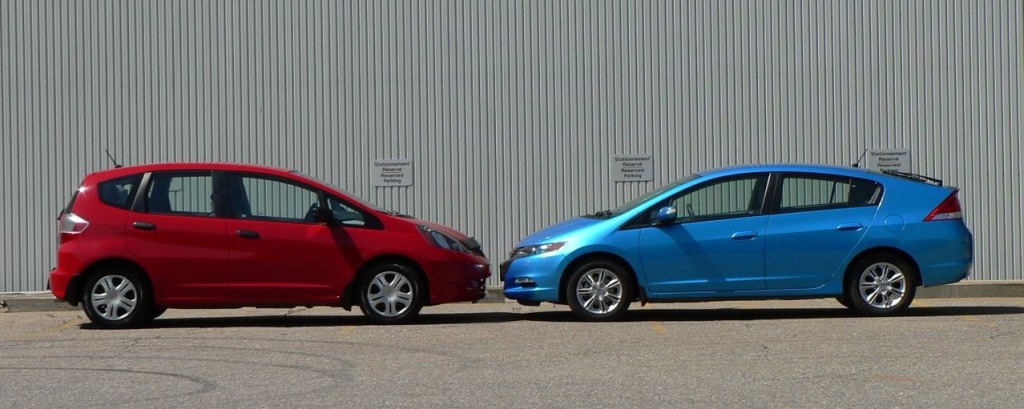Comparo: Honda Insight versus Honda Fit
Story and photos by John LeBlanc
Let’s face it: the 2010 Honda Insight clearly exists because of the unexpected success of the Toyota Prius. One look at the Honda’s egg-on-wheels profile clearly gives the impersonation away.
But the also-new-for 2010 Prius is larger, more powerful, can run on electric power alone and is potentially thousands of dollars more expensive, making the Insight vs. Prius matchups in other publications much like pitting Bambi against Godzilla – the outcome is obvious.
So unless you’re going to comparison-shop it with a second-hand 2004-09 Prius, the Insight’s main rivals are other fuel-sipping five-passenger subcompacts. Say, like the Honda hybrid’s showroom mate, the Fit.
SECOND PLACE: 2010 Honda Insight LX
For a moment, forget about the Insight’s ego-boosting hybrid badge. Is it a better car overall than the Fit?
The $23,900 base model Insight LX is the least expensive hybrid in Canada.
Based on MSRPs alone, it costs $5,320 more than a comparably equipped Fit LX. But include the Ontario government’s $2,000 hybrid vehicle rebate, and both end up costing relatively the same to run over time.
(If you want or need alloy wheels, stability control and traction control, Bluetooth, navigation system, paddle shifters and other doodads, there’s also a $27,500 Insight EX model.)
As you would hope and expect, the Insight LX does use less fuel than its gas-only counterpart. It’s rated at 4.8 L/100 km (58.8 m.p.g.) in the city, 4.5 L (62.7 m.p.g.) on the highway.
A Fit LX (with a $1,200 five-speed autobox) comes in at 7.1 L (39.7 m.p.g.) and 5.5 L (51 m.p.g.), respectively.
All Insights come with an 98 hp, 1.3-litre four-cylinder engine. Supplemented by a 13 hp electric motor, the total available torque is an impressive 123 lb.-ft.
The Insight LX can go 0-to-100 km/h in about 10.5 seconds. About a half-second behind a Fit LX with an autobox (a five-speed manual Fit trounces the Insight, taking just 8.5 seconds).
Despite some extra eco-driving features, the Insight’s driver instrumentation and controls will look familiar to Fit or Civic owners. Its front seats are large and supportive. But the shorter and taller Fit is much more accommodating for rear-seat passengers. Plus it has a more generous and flexible cargo bay.
Then there’s how the Insight drives. Its firm suspension means it handles with more aplomb than the larger and softer ’10 Prius.
But up against the Fit – one of our favourite fun-to-drive subcompacts – the Insight appears to be saddled with the usual driving quirks found in a hybrid.
First, its continuously variable transmission doesn’t help ameliorate the small four’s tinniness when it’s caned. Secondly, when the auto stop-start has the engine turned off, there’s always a slight hiccup for the engine to start up again when pulling away. In addition, its regenerative brakes are grabby around town.
At low speeds, the Insight’s steering feels like stirring a pot of glue, then quickly lightens at higher speeds.
WHY BUY? (Relatively) low purchase price, excellent fuel economy, “hybrid” badge, more fun-to-drive than the larger 2010 Prius.
WHY NOT? Typical hybrid driving compromises, tight rear-passenger and cargo room.
FIRST PLACE: 2009 Honda Fit LX
Yes. The Insight gets about 35 per cent better fuel economy than the Fit LX. And it drives comparatively well – for a hybrid. But it just can’t cut it against the more conventional Fit when it comes to performance, handling, roominess and practicality.
Keep in mind: Fits without A/C, alloys or an autobox can cost as little as $14.980. But to outfit it closer to what the Insight LX has, you’re looking at $18,580 for a Fit LX.
From the driver’s seat, any small car would have a hard time ousting the Fit. If not as parsimonious as the Insight hybrid, the gas-only Honda five-door is the most fun-to-drive subcompact on the market.
With only 106 lb.-ft., the Fit’s 1.8-litre four-banger can’t match the electric-motor-aided Insight. But with 117 hp, and a more refined sound and feel when being hurried, the Fit’s drivetrain is a much more measurable experience in day-to-day driving.
The Fit’s is steering is lighter, quicker, more precise and linear than the Insight’s. Its firm suspension also keeps its body motions in check. And there’s less understeer than the hybrid, which likes to plow ahead when pushed.
The only downside to the Fit’s sports compact nature is its ride quality. Compared to the softer Insight, you’ll feel more cracks and potholes.
As sporty as the Fit is to drive, it also scores over the tighter-fitting Insight from a practical point of view.
Although similar in width, the compromises in packaging two drivetrains and being a slave to aerodynamics means the Insight is less roomy than the Fit.
There’s less passenger and cargo room in the hybrid, whether the rear seats are up or down.
Rear headroom is also noticeably tighter because of the near-flat rear glass.
Plus the Insight doesn’t get the Fit’s unique rear-seat bottom cushions that can fold up to create a flat floor.
Practical, fun-to-drive and, in the end, costing about the same to operate, the Fit may not have the Insight’s sexy, blue hybrid badge – but it is the better car overall.
WHY BUY? Roomy and flexible interior, zippy performance, sporty handling.
WHY NOT? Ride quality, relative fuel economy.
Comments
3 Responses to “Comparo: Honda Insight versus Honda Fit”








![[del.icio.us]](https://www.straight-six.com/wp-content/plugins/bookmarkify/delicious.png)
![[Digg]](https://www.straight-six.com/wp-content/plugins/bookmarkify/digg.png)
![[Facebook]](https://www.straight-six.com/wp-content/plugins/bookmarkify/facebook.png)
![[Google]](https://www.straight-six.com/wp-content/plugins/bookmarkify/google.png)
![[Reddit]](https://www.straight-six.com/wp-content/plugins/bookmarkify/reddit.png)
![[StumbleUpon]](https://www.straight-six.com/wp-content/plugins/bookmarkify/stumbleupon.png)
![[Twitter]](https://www.straight-six.com/wp-content/plugins/bookmarkify/twitter.png)
![[Email]](https://www.straight-six.com/wp-content/plugins/bookmarkify/email.png)
July 19th, 2010 @ 8:36 am
[…] alone.) While in the ensuing years, its “mild hybrid” system (found in Civics and today’s Insight and CR-Z) has proven Honda never really felt been fully on board with hyrbrids the way rival […]
August 25th, 2010 @ 7:44 pm
[…] its hybrid lineup. Not that anyone will notice, but allegedly, the Civic Hybrid and the much-hyped Insight will be leaving showrooms, just as its new CR-Zed hybrid sports coupe […]
May 13th, 2011 @ 7:52 am
[…] […]